Leading People: Evaluate Leadership Styles and Organizational Impact
VerifiedAdded on 2023/01/05
|9
|2450
|86
Report
AI Summary
This report delves into the multifaceted aspects of leadership, with a specific focus on inclusive leadership styles and their profound impact on organizational culture and diversity management. The introduction establishes the significance of effective leadership in motivating individuals and teams, using KFC as a case study to highlight the importance of understanding diverse employee needs. Task 1 evaluates various inclusive leadership styles and models, emphasizing characteristics like visible dedication, humility, bias tolerance, curiosity, cultural intelligence, and efficient cooperation. It underscores the importance of cultivating a dynamic and multicultural workforce. Task 2 assesses the impact of leadership on organizational culture and diversity management, highlighting the correlation between good leadership and a thriving corporate environment. The report discusses the benefits and challenges of organizational diversity, including learning, experience, knowledge, international skills, and reputation. The conclusion reiterates the importance of leaders in fostering accountability and responsibility within their organizations, emphasizing the need for continuous improvement and adaptation to drive positive change.
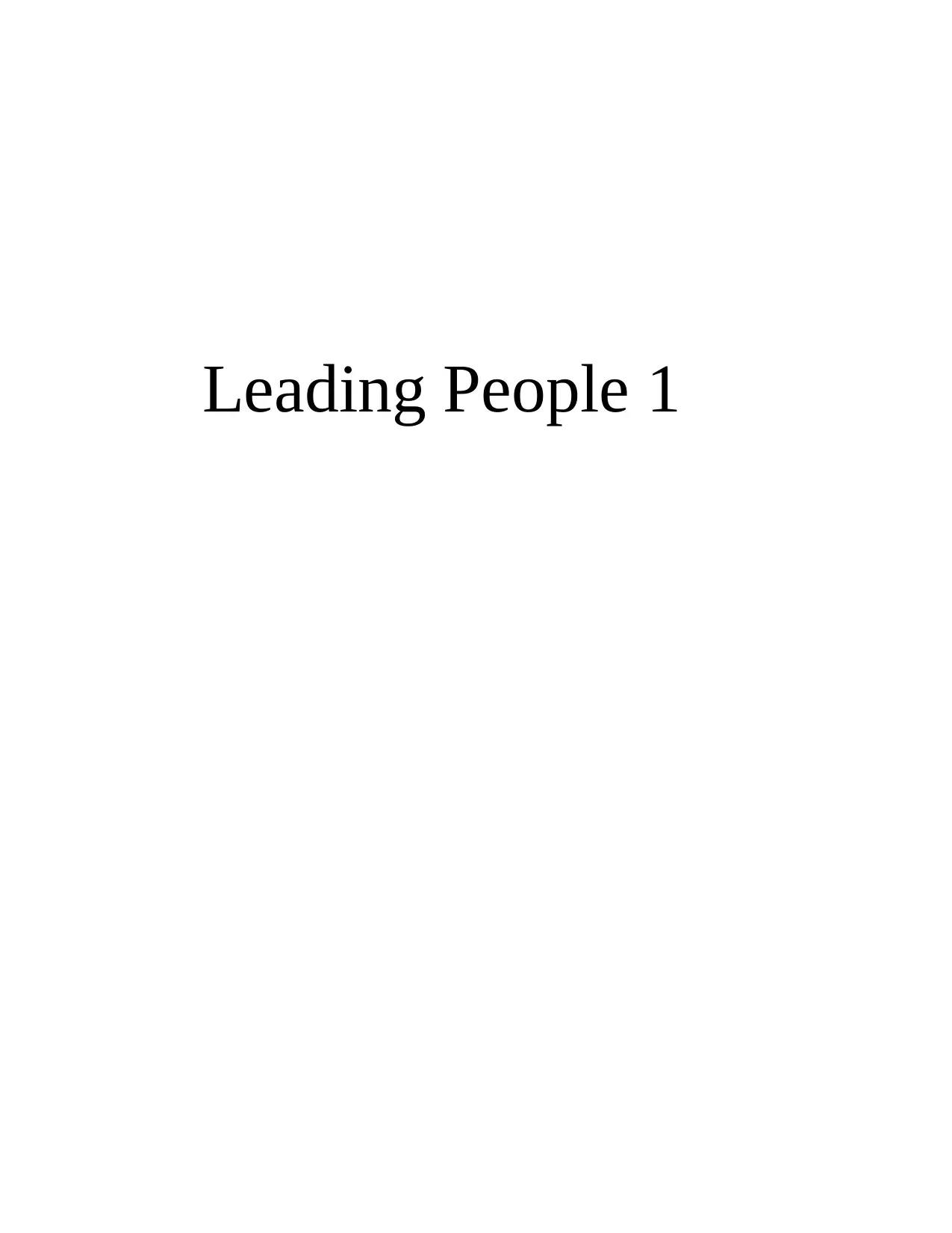
Leading People 1
Paraphrase This Document
Need a fresh take? Get an instant paraphrase of this document with our AI Paraphraser
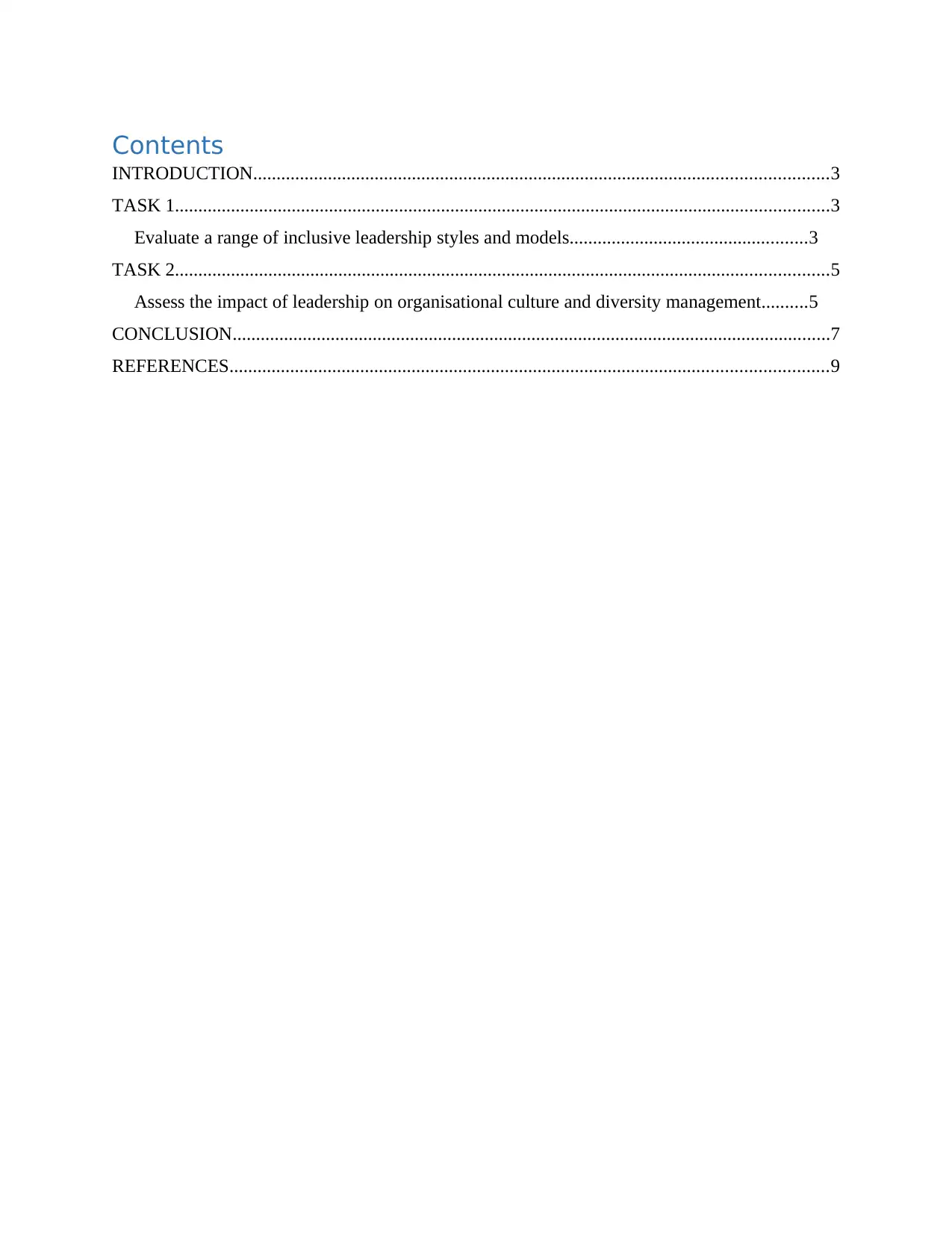
Contents
INTRODUCTION...........................................................................................................................3
TASK 1............................................................................................................................................3
Evaluate a range of inclusive leadership styles and models...................................................3
TASK 2............................................................................................................................................5
Assess the impact of leadership on organisational culture and diversity management..........5
CONCLUSION................................................................................................................................7
REFERENCES................................................................................................................................9
INTRODUCTION...........................................................................................................................3
TASK 1............................................................................................................................................3
Evaluate a range of inclusive leadership styles and models...................................................3
TASK 2............................................................................................................................................5
Assess the impact of leadership on organisational culture and diversity management..........5
CONCLUSION................................................................................................................................7
REFERENCES................................................................................................................................9
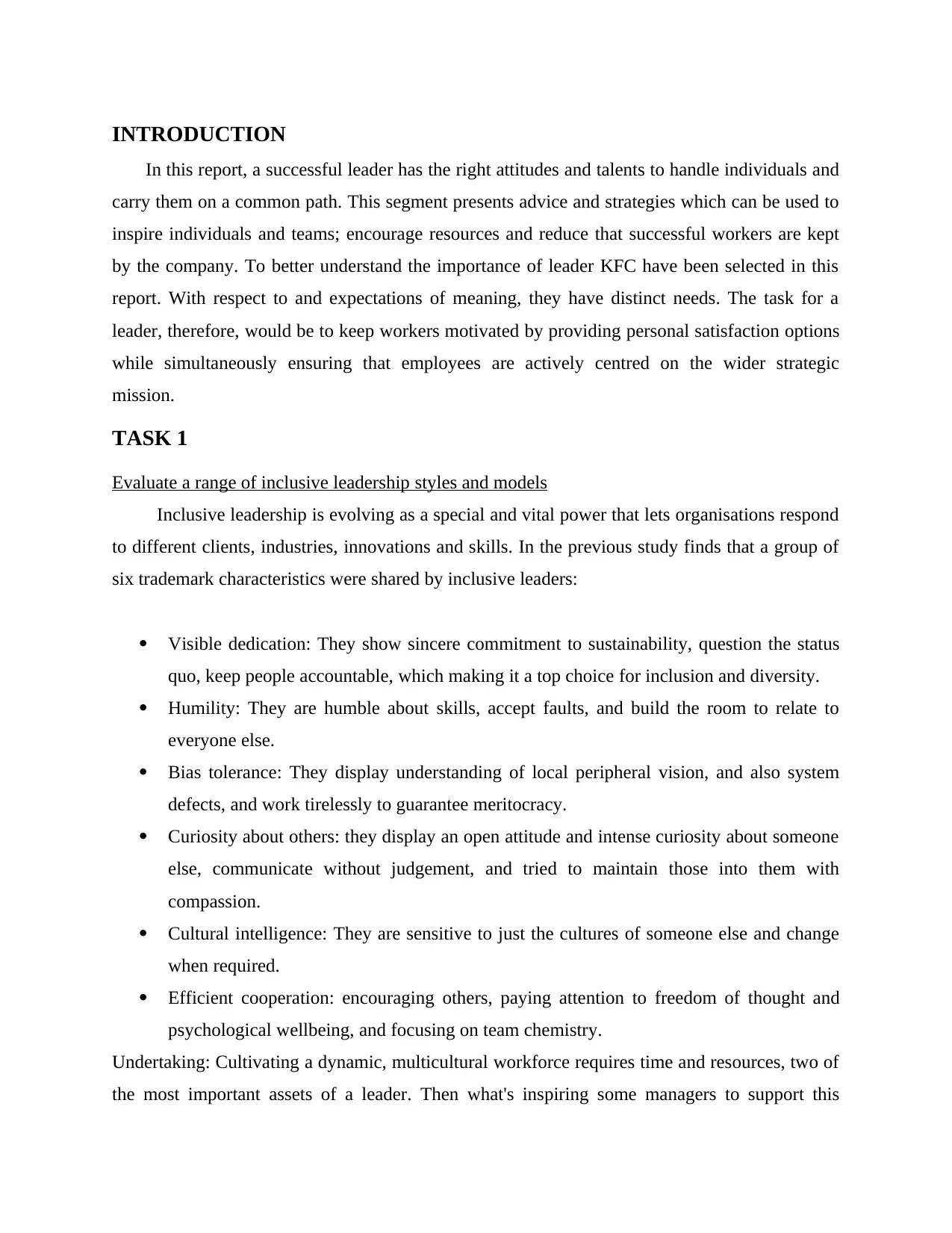
INTRODUCTION
In this report, a successful leader has the right attitudes and talents to handle individuals and
carry them on a common path. This segment presents advice and strategies which can be used to
inspire individuals and teams; encourage resources and reduce that successful workers are kept
by the company. To better understand the importance of leader KFC have been selected in this
report. With respect to and expectations of meaning, they have distinct needs. The task for a
leader, therefore, would be to keep workers motivated by providing personal satisfaction options
while simultaneously ensuring that employees are actively centred on the wider strategic
mission.
TASK 1
Evaluate a range of inclusive leadership styles and models
Inclusive leadership is evolving as a special and vital power that lets organisations respond
to different clients, industries, innovations and skills. In the previous study finds that a group of
six trademark characteristics were shared by inclusive leaders:
Visible dedication: They show sincere commitment to sustainability, question the status
quo, keep people accountable, which making it a top choice for inclusion and diversity.
Humility: They are humble about skills, accept faults, and build the room to relate to
everyone else.
Bias tolerance: They display understanding of local peripheral vision, and also system
defects, and work tirelessly to guarantee meritocracy.
Curiosity about others: they display an open attitude and intense curiosity about someone
else, communicate without judgement, and tried to maintain those into them with
compassion.
Cultural intelligence: They are sensitive to just the cultures of someone else and change
when required.
Efficient cooperation: encouraging others, paying attention to freedom of thought and
psychological wellbeing, and focusing on team chemistry.
Undertaking: Cultivating a dynamic, multicultural workforce requires time and resources, two of
the most important assets of a leader. Then what's inspiring some managers to support this
In this report, a successful leader has the right attitudes and talents to handle individuals and
carry them on a common path. This segment presents advice and strategies which can be used to
inspire individuals and teams; encourage resources and reduce that successful workers are kept
by the company. To better understand the importance of leader KFC have been selected in this
report. With respect to and expectations of meaning, they have distinct needs. The task for a
leader, therefore, would be to keep workers motivated by providing personal satisfaction options
while simultaneously ensuring that employees are actively centred on the wider strategic
mission.
TASK 1
Evaluate a range of inclusive leadership styles and models
Inclusive leadership is evolving as a special and vital power that lets organisations respond
to different clients, industries, innovations and skills. In the previous study finds that a group of
six trademark characteristics were shared by inclusive leaders:
Visible dedication: They show sincere commitment to sustainability, question the status
quo, keep people accountable, which making it a top choice for inclusion and diversity.
Humility: They are humble about skills, accept faults, and build the room to relate to
everyone else.
Bias tolerance: They display understanding of local peripheral vision, and also system
defects, and work tirelessly to guarantee meritocracy.
Curiosity about others: they display an open attitude and intense curiosity about someone
else, communicate without judgement, and tried to maintain those into them with
compassion.
Cultural intelligence: They are sensitive to just the cultures of someone else and change
when required.
Efficient cooperation: encouraging others, paying attention to freedom of thought and
psychological wellbeing, and focusing on team chemistry.
Undertaking: Cultivating a dynamic, multicultural workforce requires time and resources, two of
the most important assets of a leader. Then what's inspiring some managers to support this
⊘ This is a preview!⊘
Do you want full access?
Subscribe today to unlock all pages.

Trusted by 1+ million students worldwide
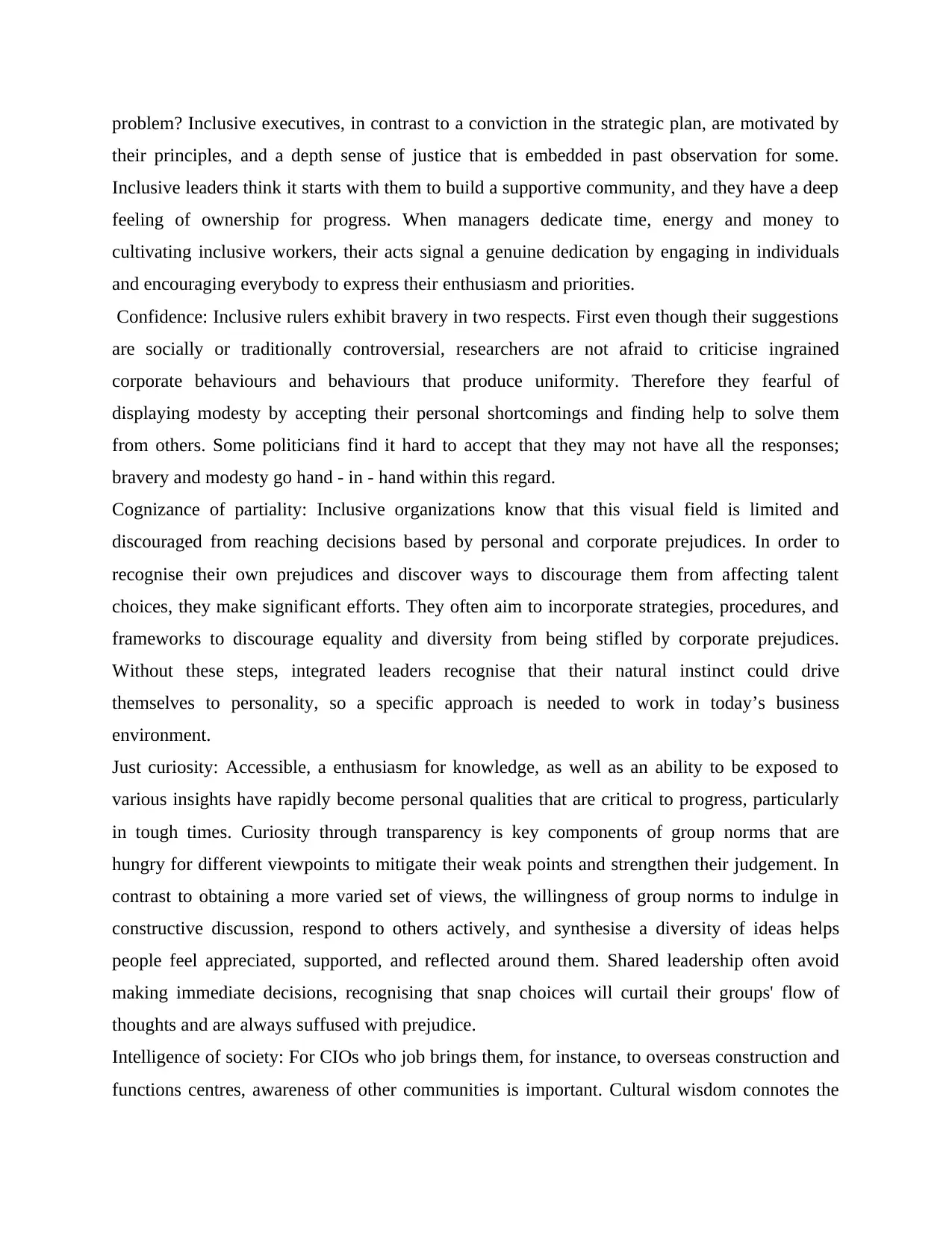
problem? Inclusive executives, in contrast to a conviction in the strategic plan, are motivated by
their principles, and a depth sense of justice that is embedded in past observation for some.
Inclusive leaders think it starts with them to build a supportive community, and they have a deep
feeling of ownership for progress. When managers dedicate time, energy and money to
cultivating inclusive workers, their acts signal a genuine dedication by engaging in individuals
and encouraging everybody to express their enthusiasm and priorities.
Confidence: Inclusive rulers exhibit bravery in two respects. First even though their suggestions
are socially or traditionally controversial, researchers are not afraid to criticise ingrained
corporate behaviours and behaviours that produce uniformity. Therefore they fearful of
displaying modesty by accepting their personal shortcomings and finding help to solve them
from others. Some politicians find it hard to accept that they may not have all the responses;
bravery and modesty go hand - in - hand within this regard.
Cognizance of partiality: Inclusive organizations know that this visual field is limited and
discouraged from reaching decisions based by personal and corporate prejudices. In order to
recognise their own prejudices and discover ways to discourage them from affecting talent
choices, they make significant efforts. They often aim to incorporate strategies, procedures, and
frameworks to discourage equality and diversity from being stifled by corporate prejudices.
Without these steps, integrated leaders recognise that their natural instinct could drive
themselves to personality, so a specific approach is needed to work in today’s business
environment.
Just curiosity: Accessible, a enthusiasm for knowledge, as well as an ability to be exposed to
various insights have rapidly become personal qualities that are critical to progress, particularly
in tough times. Curiosity through transparency is key components of group norms that are
hungry for different viewpoints to mitigate their weak points and strengthen their judgement. In
contrast to obtaining a more varied set of views, the willingness of group norms to indulge in
constructive discussion, respond to others actively, and synthesise a diversity of ideas helps
people feel appreciated, supported, and reflected around them. Shared leadership often avoid
making immediate decisions, recognising that snap choices will curtail their groups' flow of
thoughts and are always suffused with prejudice.
Intelligence of society: For CIOs who job brings them, for instance, to overseas construction and
functions centres, awareness of other communities is important. Cultural wisdom connotes the
their principles, and a depth sense of justice that is embedded in past observation for some.
Inclusive leaders think it starts with them to build a supportive community, and they have a deep
feeling of ownership for progress. When managers dedicate time, energy and money to
cultivating inclusive workers, their acts signal a genuine dedication by engaging in individuals
and encouraging everybody to express their enthusiasm and priorities.
Confidence: Inclusive rulers exhibit bravery in two respects. First even though their suggestions
are socially or traditionally controversial, researchers are not afraid to criticise ingrained
corporate behaviours and behaviours that produce uniformity. Therefore they fearful of
displaying modesty by accepting their personal shortcomings and finding help to solve them
from others. Some politicians find it hard to accept that they may not have all the responses;
bravery and modesty go hand - in - hand within this regard.
Cognizance of partiality: Inclusive organizations know that this visual field is limited and
discouraged from reaching decisions based by personal and corporate prejudices. In order to
recognise their own prejudices and discover ways to discourage them from affecting talent
choices, they make significant efforts. They often aim to incorporate strategies, procedures, and
frameworks to discourage equality and diversity from being stifled by corporate prejudices.
Without these steps, integrated leaders recognise that their natural instinct could drive
themselves to personality, so a specific approach is needed to work in today’s business
environment.
Just curiosity: Accessible, a enthusiasm for knowledge, as well as an ability to be exposed to
various insights have rapidly become personal qualities that are critical to progress, particularly
in tough times. Curiosity through transparency is key components of group norms that are
hungry for different viewpoints to mitigate their weak points and strengthen their judgement. In
contrast to obtaining a more varied set of views, the willingness of group norms to indulge in
constructive discussion, respond to others actively, and synthesise a diversity of ideas helps
people feel appreciated, supported, and reflected around them. Shared leadership often avoid
making immediate decisions, recognising that snap choices will curtail their groups' flow of
thoughts and are always suffused with prejudice.
Intelligence of society: For CIOs who job brings them, for instance, to overseas construction and
functions centres, awareness of other communities is important. Cultural wisdom connotes the
Paraphrase This Document
Need a fresh take? Get an instant paraphrase of this document with our AI Paraphraser
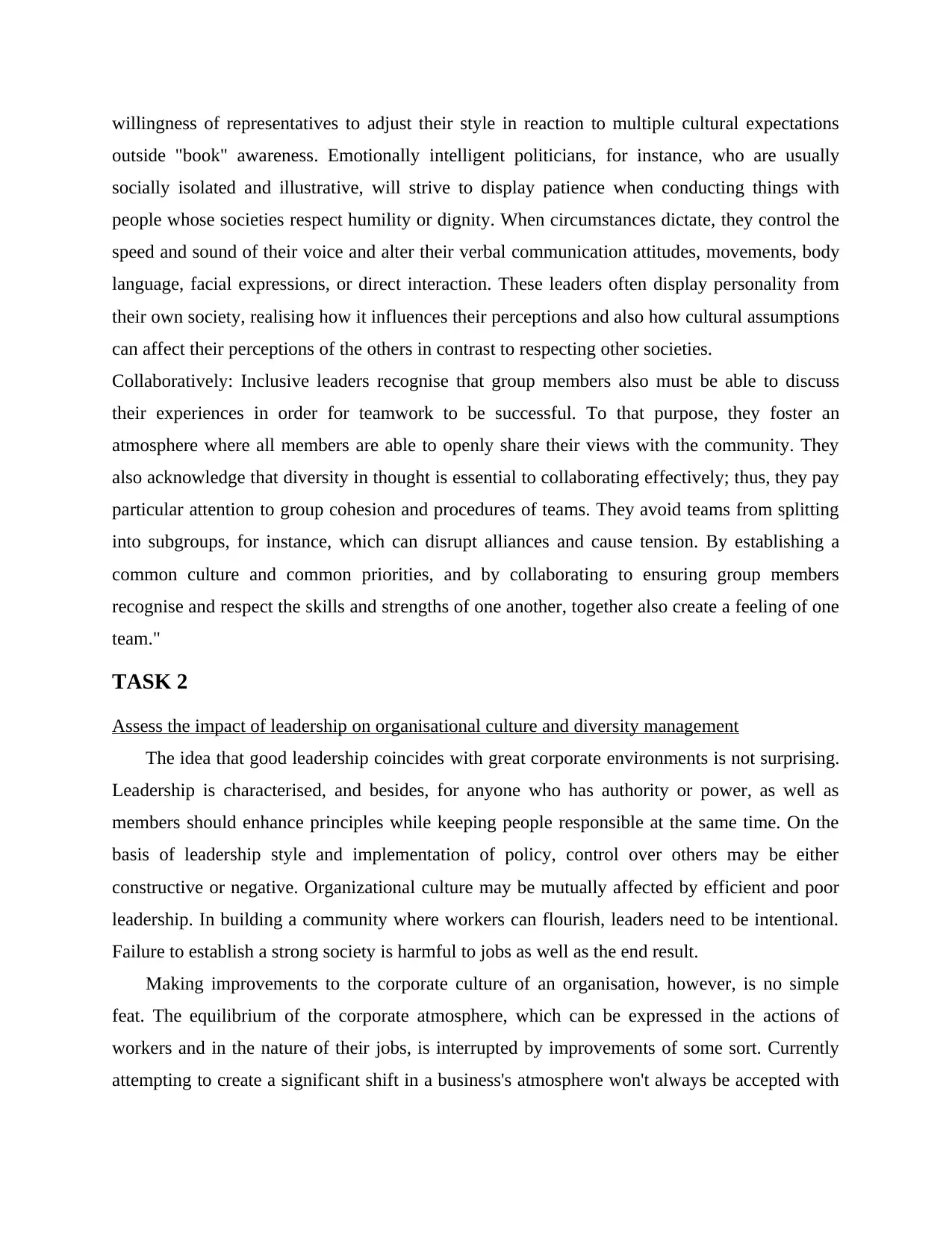
willingness of representatives to adjust their style in reaction to multiple cultural expectations
outside "book" awareness. Emotionally intelligent politicians, for instance, who are usually
socially isolated and illustrative, will strive to display patience when conducting things with
people whose societies respect humility or dignity. When circumstances dictate, they control the
speed and sound of their voice and alter their verbal communication attitudes, movements, body
language, facial expressions, or direct interaction. These leaders often display personality from
their own society, realising how it influences their perceptions and also how cultural assumptions
can affect their perceptions of the others in contrast to respecting other societies.
Collaboratively: Inclusive leaders recognise that group members also must be able to discuss
their experiences in order for teamwork to be successful. To that purpose, they foster an
atmosphere where all members are able to openly share their views with the community. They
also acknowledge that diversity in thought is essential to collaborating effectively; thus, they pay
particular attention to group cohesion and procedures of teams. They avoid teams from splitting
into subgroups, for instance, which can disrupt alliances and cause tension. By establishing a
common culture and common priorities, and by collaborating to ensuring group members
recognise and respect the skills and strengths of one another, together also create a feeling of one
team."
TASK 2
Assess the impact of leadership on organisational culture and diversity management
The idea that good leadership coincides with great corporate environments is not surprising.
Leadership is characterised, and besides, for anyone who has authority or power, as well as
members should enhance principles while keeping people responsible at the same time. On the
basis of leadership style and implementation of policy, control over others may be either
constructive or negative. Organizational culture may be mutually affected by efficient and poor
leadership. In building a community where workers can flourish, leaders need to be intentional.
Failure to establish a strong society is harmful to jobs as well as the end result.
Making improvements to the corporate culture of an organisation, however, is no simple
feat. The equilibrium of the corporate atmosphere, which can be expressed in the actions of
workers and in the nature of their jobs, is interrupted by improvements of some sort. Currently
attempting to create a significant shift in a business's atmosphere won't always be accepted with
outside "book" awareness. Emotionally intelligent politicians, for instance, who are usually
socially isolated and illustrative, will strive to display patience when conducting things with
people whose societies respect humility or dignity. When circumstances dictate, they control the
speed and sound of their voice and alter their verbal communication attitudes, movements, body
language, facial expressions, or direct interaction. These leaders often display personality from
their own society, realising how it influences their perceptions and also how cultural assumptions
can affect their perceptions of the others in contrast to respecting other societies.
Collaboratively: Inclusive leaders recognise that group members also must be able to discuss
their experiences in order for teamwork to be successful. To that purpose, they foster an
atmosphere where all members are able to openly share their views with the community. They
also acknowledge that diversity in thought is essential to collaborating effectively; thus, they pay
particular attention to group cohesion and procedures of teams. They avoid teams from splitting
into subgroups, for instance, which can disrupt alliances and cause tension. By establishing a
common culture and common priorities, and by collaborating to ensuring group members
recognise and respect the skills and strengths of one another, together also create a feeling of one
team."
TASK 2
Assess the impact of leadership on organisational culture and diversity management
The idea that good leadership coincides with great corporate environments is not surprising.
Leadership is characterised, and besides, for anyone who has authority or power, as well as
members should enhance principles while keeping people responsible at the same time. On the
basis of leadership style and implementation of policy, control over others may be either
constructive or negative. Organizational culture may be mutually affected by efficient and poor
leadership. In building a community where workers can flourish, leaders need to be intentional.
Failure to establish a strong society is harmful to jobs as well as the end result.
Making improvements to the corporate culture of an organisation, however, is no simple
feat. The equilibrium of the corporate atmosphere, which can be expressed in the actions of
workers and in the nature of their jobs, is interrupted by improvements of some sort. Currently
attempting to create a significant shift in a business's atmosphere won't always be accepted with
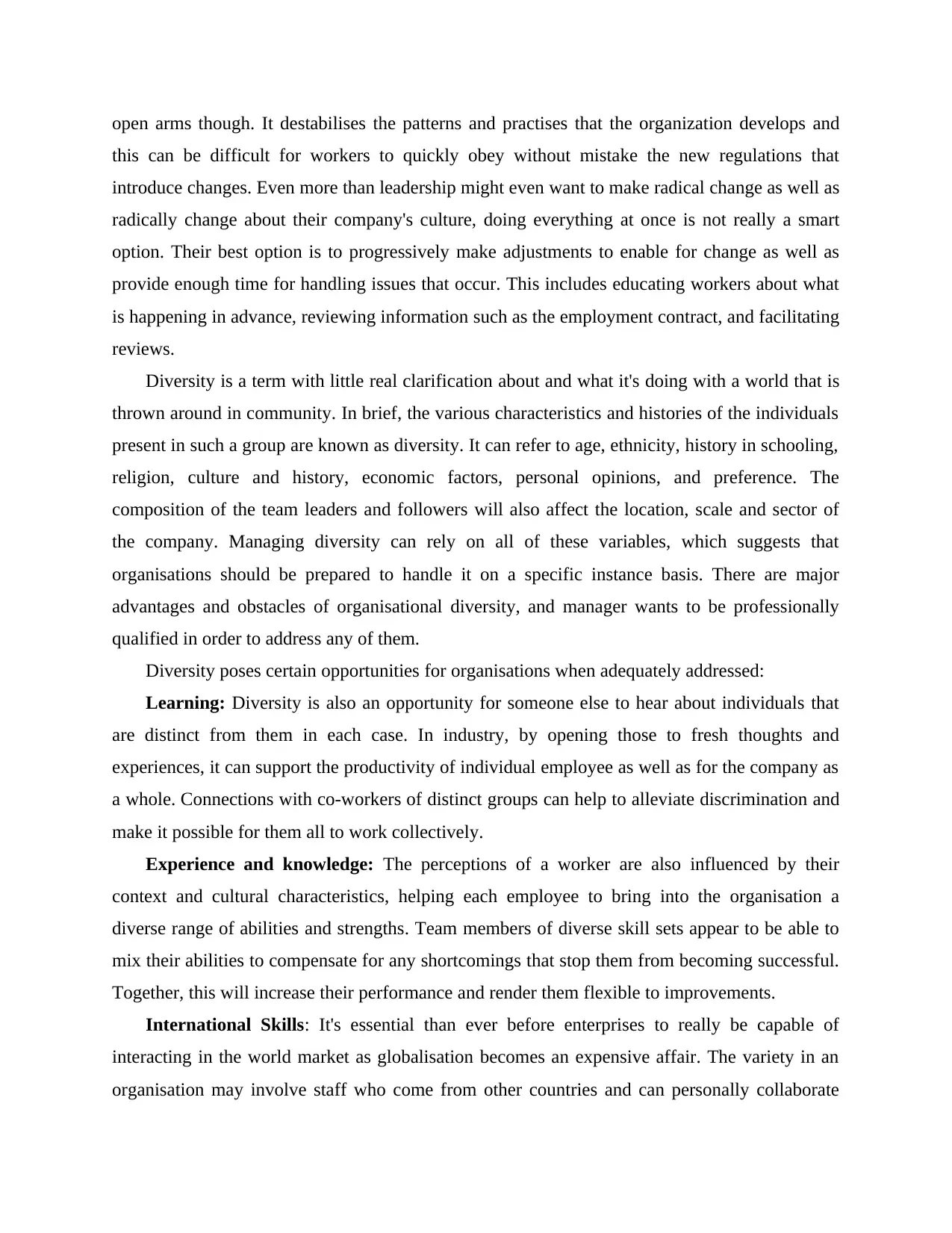
open arms though. It destabilises the patterns and practises that the organization develops and
this can be difficult for workers to quickly obey without mistake the new regulations that
introduce changes. Even more than leadership might even want to make radical change as well as
radically change about their company's culture, doing everything at once is not really a smart
option. Their best option is to progressively make adjustments to enable for change as well as
provide enough time for handling issues that occur. This includes educating workers about what
is happening in advance, reviewing information such as the employment contract, and facilitating
reviews.
Diversity is a term with little real clarification about and what it's doing with a world that is
thrown around in community. In brief, the various characteristics and histories of the individuals
present in such a group are known as diversity. It can refer to age, ethnicity, history in schooling,
religion, culture and history, economic factors, personal opinions, and preference. The
composition of the team leaders and followers will also affect the location, scale and sector of
the company. Managing diversity can rely on all of these variables, which suggests that
organisations should be prepared to handle it on a specific instance basis. There are major
advantages and obstacles of organisational diversity, and manager wants to be professionally
qualified in order to address any of them.
Diversity poses certain opportunities for organisations when adequately addressed:
Learning: Diversity is also an opportunity for someone else to hear about individuals that
are distinct from them in each case. In industry, by opening those to fresh thoughts and
experiences, it can support the productivity of individual employee as well as for the company as
a whole. Connections with co-workers of distinct groups can help to alleviate discrimination and
make it possible for them all to work collectively.
Experience and knowledge: The perceptions of a worker are also influenced by their
context and cultural characteristics, helping each employee to bring into the organisation a
diverse range of abilities and strengths. Team members of diverse skill sets appear to be able to
mix their abilities to compensate for any shortcomings that stop them from becoming successful.
Together, this will increase their performance and render them flexible to improvements.
International Skills: It's essential than ever before enterprises to really be capable of
interacting in the world market as globalisation becomes an expensive affair. The variety in an
organisation may involve staff who come from other countries and can personally collaborate
this can be difficult for workers to quickly obey without mistake the new regulations that
introduce changes. Even more than leadership might even want to make radical change as well as
radically change about their company's culture, doing everything at once is not really a smart
option. Their best option is to progressively make adjustments to enable for change as well as
provide enough time for handling issues that occur. This includes educating workers about what
is happening in advance, reviewing information such as the employment contract, and facilitating
reviews.
Diversity is a term with little real clarification about and what it's doing with a world that is
thrown around in community. In brief, the various characteristics and histories of the individuals
present in such a group are known as diversity. It can refer to age, ethnicity, history in schooling,
religion, culture and history, economic factors, personal opinions, and preference. The
composition of the team leaders and followers will also affect the location, scale and sector of
the company. Managing diversity can rely on all of these variables, which suggests that
organisations should be prepared to handle it on a specific instance basis. There are major
advantages and obstacles of organisational diversity, and manager wants to be professionally
qualified in order to address any of them.
Diversity poses certain opportunities for organisations when adequately addressed:
Learning: Diversity is also an opportunity for someone else to hear about individuals that
are distinct from them in each case. In industry, by opening those to fresh thoughts and
experiences, it can support the productivity of individual employee as well as for the company as
a whole. Connections with co-workers of distinct groups can help to alleviate discrimination and
make it possible for them all to work collectively.
Experience and knowledge: The perceptions of a worker are also influenced by their
context and cultural characteristics, helping each employee to bring into the organisation a
diverse range of abilities and strengths. Team members of diverse skill sets appear to be able to
mix their abilities to compensate for any shortcomings that stop them from becoming successful.
Together, this will increase their performance and render them flexible to improvements.
International Skills: It's essential than ever before enterprises to really be capable of
interacting in the world market as globalisation becomes an expensive affair. The variety in an
organisation may involve staff who come from other countries and can personally collaborate
⊘ This is a preview!⊘
Do you want full access?
Subscribe today to unlock all pages.

Trusted by 1+ million students worldwide
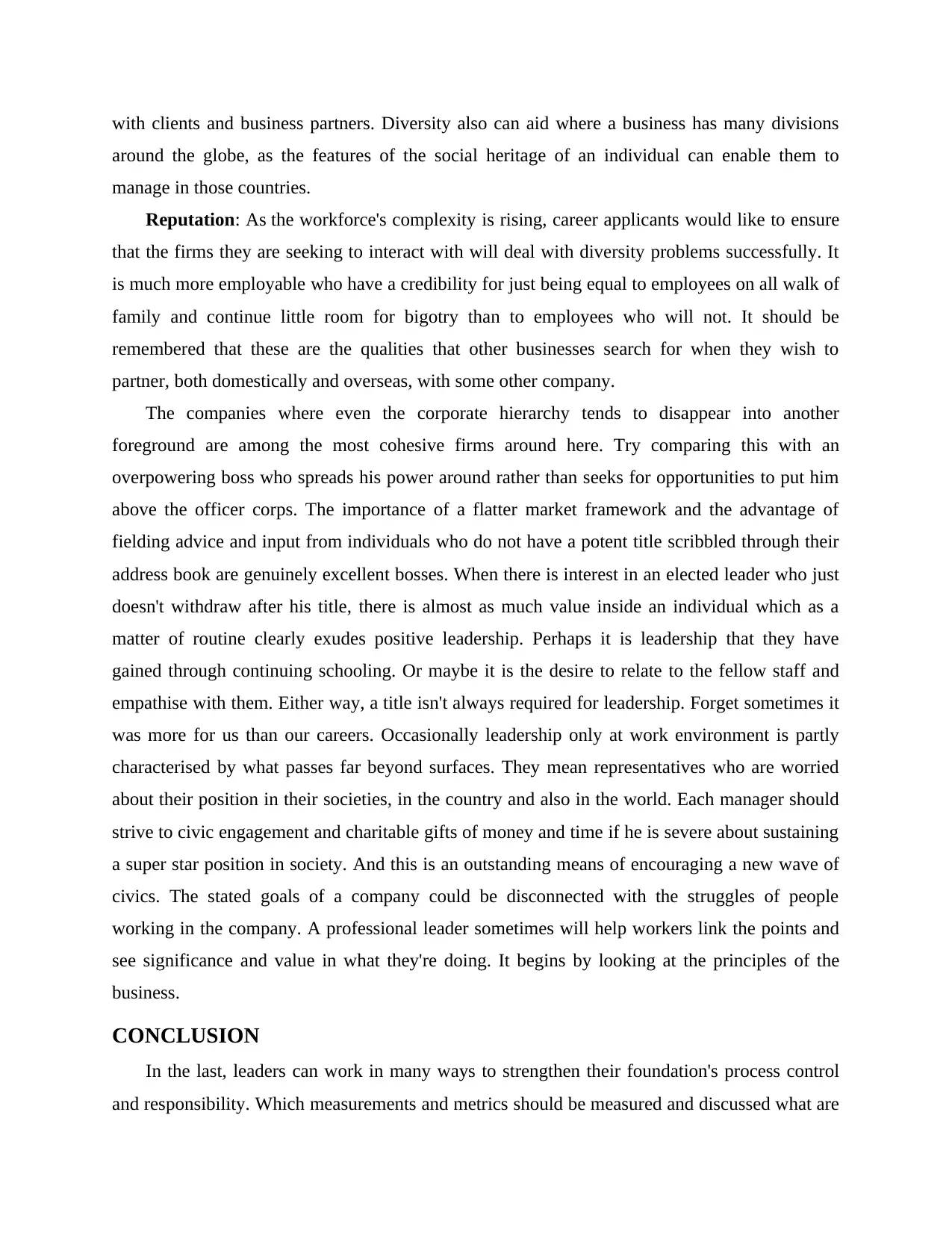
with clients and business partners. Diversity also can aid where a business has many divisions
around the globe, as the features of the social heritage of an individual can enable them to
manage in those countries.
Reputation: As the workforce's complexity is rising, career applicants would like to ensure
that the firms they are seeking to interact with will deal with diversity problems successfully. It
is much more employable who have a credibility for just being equal to employees on all walk of
family and continue little room for bigotry than to employees who will not. It should be
remembered that these are the qualities that other businesses search for when they wish to
partner, both domestically and overseas, with some other company.
The companies where even the corporate hierarchy tends to disappear into another
foreground are among the most cohesive firms around here. Try comparing this with an
overpowering boss who spreads his power around rather than seeks for opportunities to put him
above the officer corps. The importance of a flatter market framework and the advantage of
fielding advice and input from individuals who do not have a potent title scribbled through their
address book are genuinely excellent bosses. When there is interest in an elected leader who just
doesn't withdraw after his title, there is almost as much value inside an individual which as a
matter of routine clearly exudes positive leadership. Perhaps it is leadership that they have
gained through continuing schooling. Or maybe it is the desire to relate to the fellow staff and
empathise with them. Either way, a title isn't always required for leadership. Forget sometimes it
was more for us than our careers. Occasionally leadership only at work environment is partly
characterised by what passes far beyond surfaces. They mean representatives who are worried
about their position in their societies, in the country and also in the world. Each manager should
strive to civic engagement and charitable gifts of money and time if he is severe about sustaining
a super star position in society. And this is an outstanding means of encouraging a new wave of
civics. The stated goals of a company could be disconnected with the struggles of people
working in the company. A professional leader sometimes will help workers link the points and
see significance and value in what they're doing. It begins by looking at the principles of the
business.
CONCLUSION
In the last, leaders can work in many ways to strengthen their foundation's process control
and responsibility. Which measurements and metrics should be measured and discussed what are
around the globe, as the features of the social heritage of an individual can enable them to
manage in those countries.
Reputation: As the workforce's complexity is rising, career applicants would like to ensure
that the firms they are seeking to interact with will deal with diversity problems successfully. It
is much more employable who have a credibility for just being equal to employees on all walk of
family and continue little room for bigotry than to employees who will not. It should be
remembered that these are the qualities that other businesses search for when they wish to
partner, both domestically and overseas, with some other company.
The companies where even the corporate hierarchy tends to disappear into another
foreground are among the most cohesive firms around here. Try comparing this with an
overpowering boss who spreads his power around rather than seeks for opportunities to put him
above the officer corps. The importance of a flatter market framework and the advantage of
fielding advice and input from individuals who do not have a potent title scribbled through their
address book are genuinely excellent bosses. When there is interest in an elected leader who just
doesn't withdraw after his title, there is almost as much value inside an individual which as a
matter of routine clearly exudes positive leadership. Perhaps it is leadership that they have
gained through continuing schooling. Or maybe it is the desire to relate to the fellow staff and
empathise with them. Either way, a title isn't always required for leadership. Forget sometimes it
was more for us than our careers. Occasionally leadership only at work environment is partly
characterised by what passes far beyond surfaces. They mean representatives who are worried
about their position in their societies, in the country and also in the world. Each manager should
strive to civic engagement and charitable gifts of money and time if he is severe about sustaining
a super star position in society. And this is an outstanding means of encouraging a new wave of
civics. The stated goals of a company could be disconnected with the struggles of people
working in the company. A professional leader sometimes will help workers link the points and
see significance and value in what they're doing. It begins by looking at the principles of the
business.
CONCLUSION
In the last, leaders can work in many ways to strengthen their foundation's process control
and responsibility. Which measurements and metrics should be measured and discussed what are
Paraphrase This Document
Need a fresh take? Get an instant paraphrase of this document with our AI Paraphraser
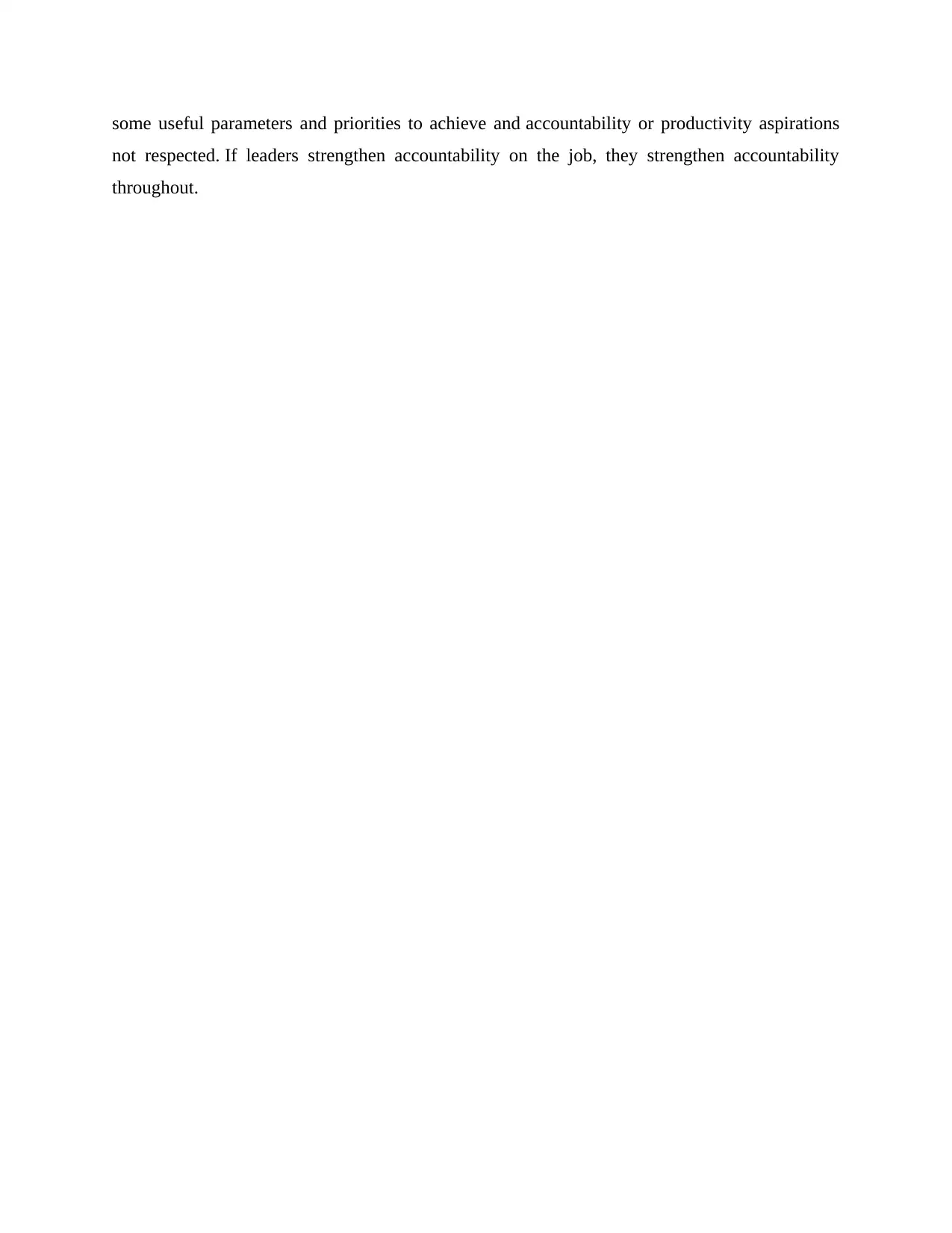
some useful parameters and priorities to achieve and accountability or productivity aspirations
not respected. If leaders strengthen accountability on the job, they strengthen accountability
throughout.
not respected. If leaders strengthen accountability on the job, they strengthen accountability
throughout.
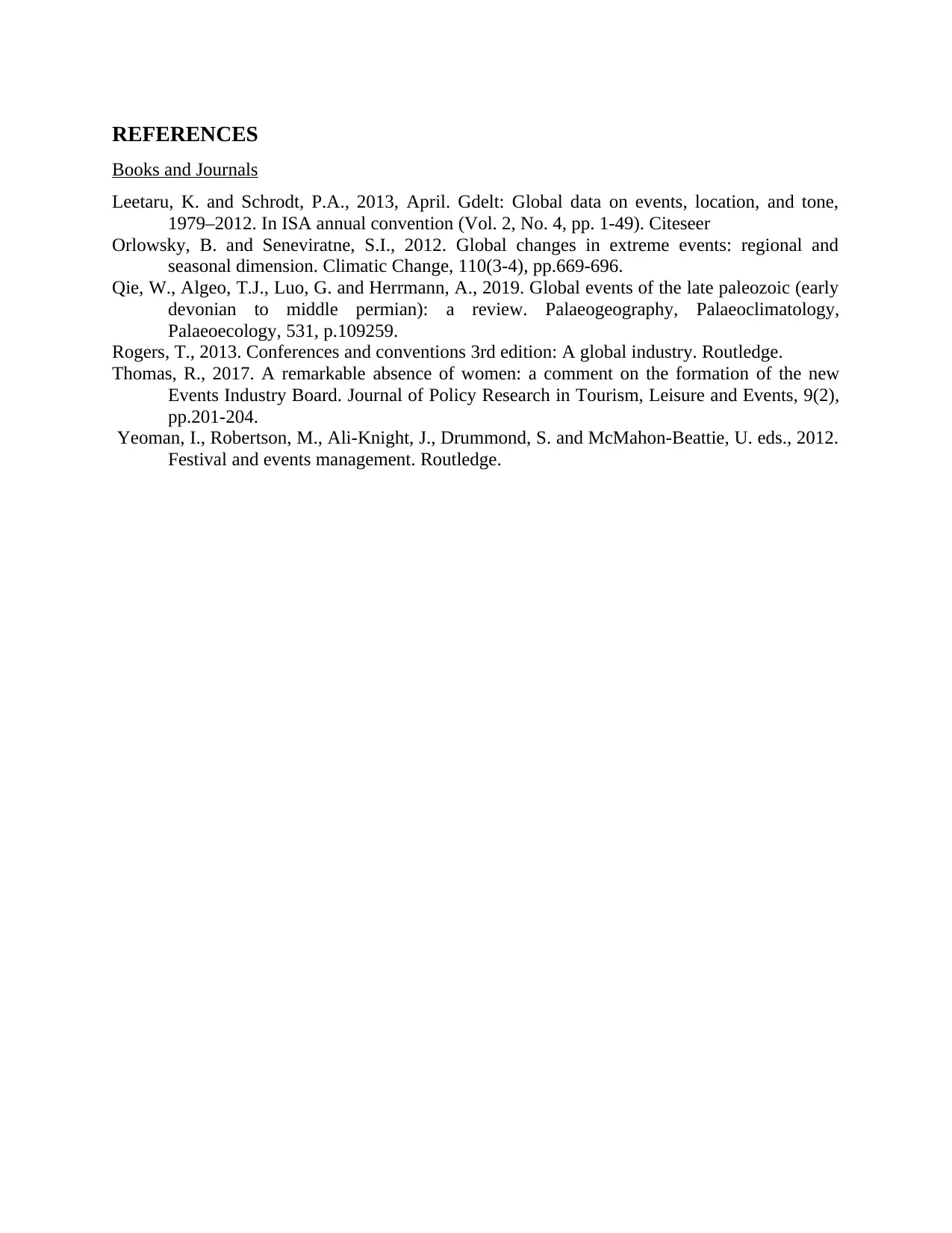
REFERENCES
Books and Journals
Leetaru, K. and Schrodt, P.A., 2013, April. Gdelt: Global data on events, location, and tone,
1979–2012. In ISA annual convention (Vol. 2, No. 4, pp. 1-49). Citeseer
Orlowsky, B. and Seneviratne, S.I., 2012. Global changes in extreme events: regional and
seasonal dimension. Climatic Change, 110(3-4), pp.669-696.
Qie, W., Algeo, T.J., Luo, G. and Herrmann, A., 2019. Global events of the late paleozoic (early
devonian to middle permian): a review. Palaeogeography, Palaeoclimatology,
Palaeoecology, 531, p.109259.
Rogers, T., 2013. Conferences and conventions 3rd edition: A global industry. Routledge.
Thomas, R., 2017. A remarkable absence of women: a comment on the formation of the new
Events Industry Board. Journal of Policy Research in Tourism, Leisure and Events, 9(2),
pp.201-204.
Yeoman, I., Robertson, M., Ali-Knight, J., Drummond, S. and McMahon-Beattie, U. eds., 2012.
Festival and events management. Routledge.
Books and Journals
Leetaru, K. and Schrodt, P.A., 2013, April. Gdelt: Global data on events, location, and tone,
1979–2012. In ISA annual convention (Vol. 2, No. 4, pp. 1-49). Citeseer
Orlowsky, B. and Seneviratne, S.I., 2012. Global changes in extreme events: regional and
seasonal dimension. Climatic Change, 110(3-4), pp.669-696.
Qie, W., Algeo, T.J., Luo, G. and Herrmann, A., 2019. Global events of the late paleozoic (early
devonian to middle permian): a review. Palaeogeography, Palaeoclimatology,
Palaeoecology, 531, p.109259.
Rogers, T., 2013. Conferences and conventions 3rd edition: A global industry. Routledge.
Thomas, R., 2017. A remarkable absence of women: a comment on the formation of the new
Events Industry Board. Journal of Policy Research in Tourism, Leisure and Events, 9(2),
pp.201-204.
Yeoman, I., Robertson, M., Ali-Knight, J., Drummond, S. and McMahon-Beattie, U. eds., 2012.
Festival and events management. Routledge.
⊘ This is a preview!⊘
Do you want full access?
Subscribe today to unlock all pages.

Trusted by 1+ million students worldwide
1 out of 9
Related Documents
Your All-in-One AI-Powered Toolkit for Academic Success.
+13062052269
info@desklib.com
Available 24*7 on WhatsApp / Email
![[object Object]](/_next/static/media/star-bottom.7253800d.svg)
Unlock your academic potential
Copyright © 2020–2025 A2Z Services. All Rights Reserved. Developed and managed by ZUCOL.





